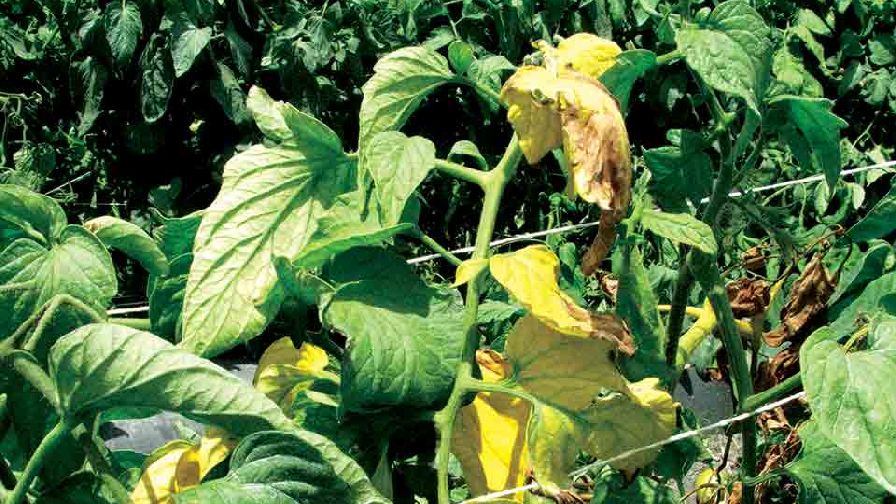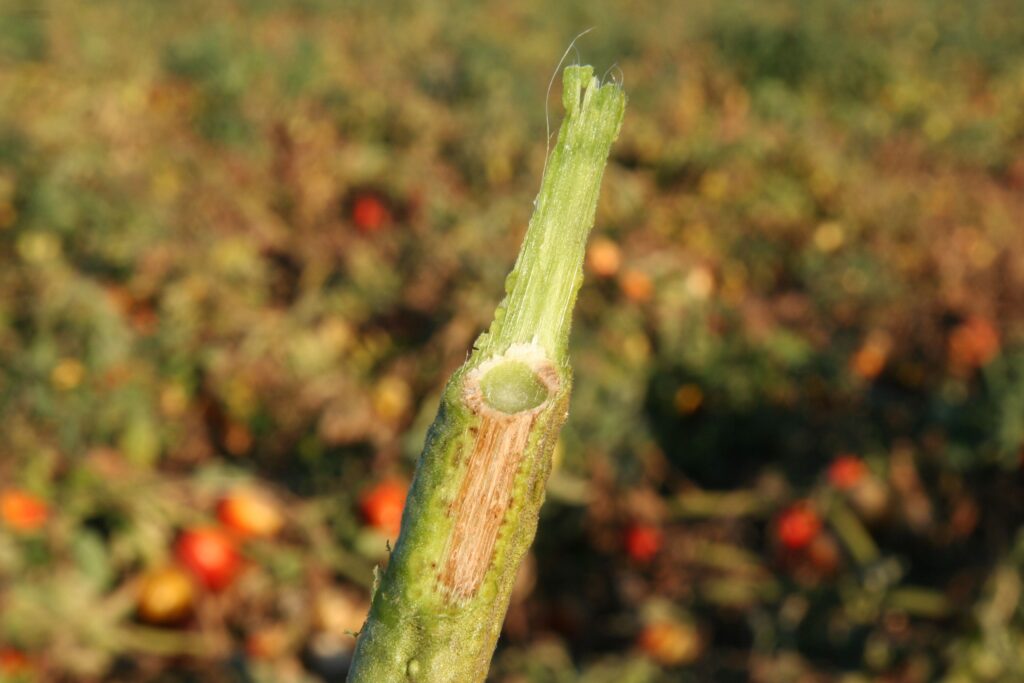Field Scouting Guide: Fusarium Wilt on Tomato

One way to identify Fusarium wilt on tomatoes? Bright-yellow leaves move from the bottom of the tomato to the top. Wilting follows the same pattern.
This installment of “Field Scouting Guide” concentrates on Fusarium oxysporum f. sp. lycopersici (fusarium wilt) on tomato plants.
We’ve reached out to University Extensionists to learn how to spot and treat this fungus. Oour contributors are Carla Thomas, Pennsylvania State Extension, and Farm Advisor Gene Miyao, University of California Cooperative Extension.
Basics
- Scientific name: Fusarium oxysporum f. sp. lycopersici
- Common name: Fusarium wilt
- Geographical Range: Wherever tomatoes are grown worldwide
- Crops affected: “Commercially cultivated tomatoes are the most economically important crop affected,” Burkle explains, “but the pathogens may affect other species in the Solanum genus, as well as cause disease in some other vegetable crops, depending on the race of the pathogen.”
Pest Impact
Miyao: In California, the fungus predominantly impacts the lower Sacramento Valley, but it has spread southward to include the San Joaquin Valley. In field production, the pathogen can infect young plants, however both symptoms and major damage occurs during the early fruit-sizing stage and later. Economic damage depends on timing, severity and of course incidence level. Infections commonly kill plants.
Thomas: This is a problem for tomato plants in Pennsylvania, both in greenhouse and open field production. If a susceptible tomato is infected with a virulent race of Fusarium oxysporum f. sp. lycopersici, losses can be very high. Incidents of Fusarium wilt causing 45% loss have been reported in recent scientific literature.
Fusarium oxysporum f. sp. lycopersici has three different types of infectious asexual structures, namely macroconidia, microconidia, and chlamydospores. Macro- or microconidia may initiate disease in a susceptible host. Chlamydospores are survival structures formed when Fusarium hyphae in a diseased host becomes stressed; infectious spores may germinate from chlamydospores when conditions are more favorable.
Disease symptoms are caused when fungal hyphae infection, grow up through the roots and clog the plant’s vascular tissues. Infected plants may wilt but more commonly develop yellow leaves, including main branches which might eventually dry and can spread to kill the entire plant.
Identification

Note the brown vascular discoloration Fusarium wilt causes.
Thomas: Fusarium wilt and Fusarium crown and root rot may be mistaken for poor irrigation or other wilt diseases and root rots due to the wilted appearance of affected plants.
Miyao: For Fusarium wilt, symptoms are yellow flagging of branches that are initially noticeable. At that stage, slicing into the affected stems near the base of the plant might reveal dark brown, vascular discoloration with these streaks extending up the stem.
In California, there are also other Fusarium pathogens causing problems. And those other Fusariums in tomato (Fusarium crown and root rot, Fusarium foot rot and another crown rot, Fusarium falciforme) have muddied the picture as well as made field diagnostics alone less reliable. Diagnostics by a lab has become the necessity as a result. We’re hopeful field tools will be developed in the future as well as a pictorial field guide to help distinguish the various Fusariums.
Recommended Treatment
Miyao: Most effective treatment is recognizing the disease, as there are resistant varieties to races 1, 2, and 3. Most commonly, races 1 and 2 are in nearly all processing tomato cultivars grown in California while seed developers have quickly moved race 3 resistance into many new cultivars. Some varieties appear to have tolerance, but under high pressure, tolerance is insufficient. Several biologicals purport to have effect on Fusarium wilt. Of the few tested, disease suppression was under achieving. Evaluations are continuing with conventional fungicides & metham.
For integrated pest management, use resistant varieties to the specific races as needed. Sanitize to reduce the rate of spread to ‘clean’ fields. Rotate tomatoes out for several years, but know that the pathogen is long-lived in the soil and recent research at UC Davis indicates many other crops and weeds can host the pathogen.
Many in the industry expect that race 3 resistance in our cultivars will be overcome in the future. It’s unclear what the time frame will be, but it’s likely within a decade or two.
Thomas: There are fungicides available to control Fusarium wilt, but managing it is best accomplished by growing resistant cultivars, fumigating the soil, rotating crops, practicing fastidious hygiene, and field and greenhouse sanitation. And take care to get disease-free transplants. Plant tomato varieties that are resistant to the known races in your area.
In the Mid-Atlantic region these are races 1, 2, and 3. Pre-plant soil fumigation with methyl bromide was a standard management strategy until its use was phased out due to it being an ozone-depleting substance. Methyl bromide may still be used with a critical use exemption, but other fumigants such as 1, 3 dichloropropene plus chloropicrin are known to be as effective as methyl bromide at controlling Fusarium wilt. Growers who don’t want to or can’t fumigate may get suppression by solarizing or steam injecting their soil or greenhouse.
Keeping soil pH above 6.0 and fertilizing with nitrate nitrogen in favor of ammonium nitrogen may limit disease development. Use bleach to sanitize wood stakes, tools, and any plastic or Styrofoam that comes in contact with plants. Also consider foot washes and hand sanitizer stations at greenhouse entrances.










